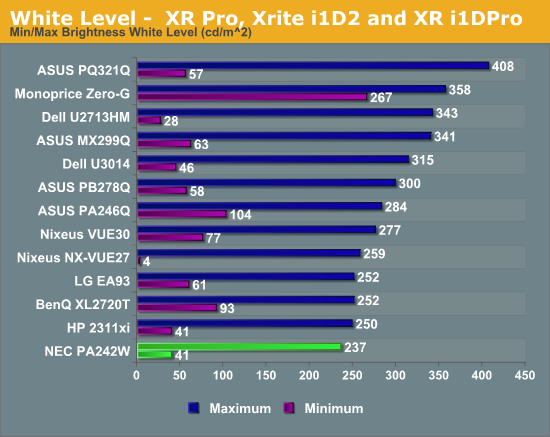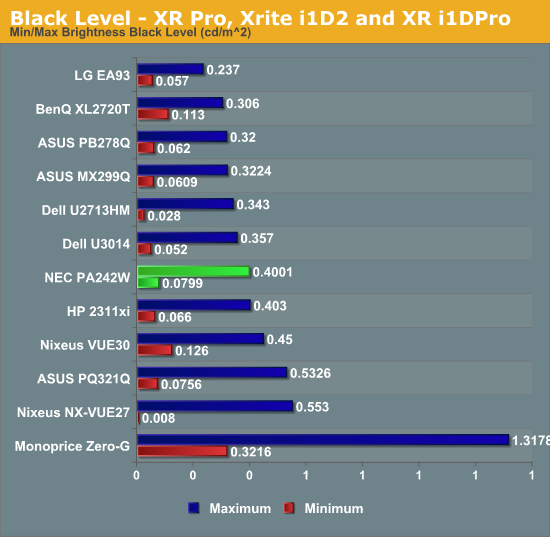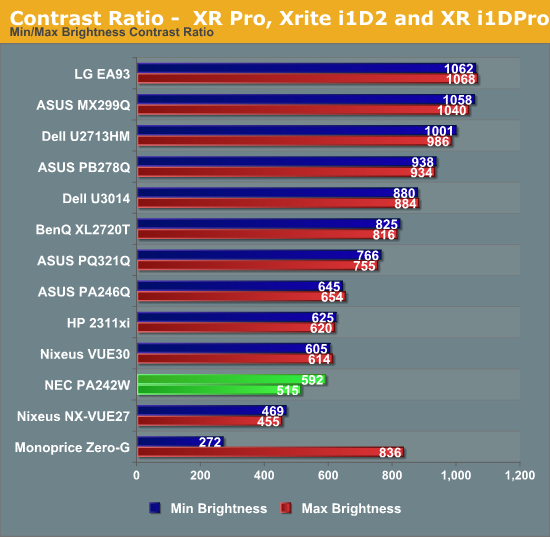NEC PA242W Monitor Review
by Chris Heinonen on September 27, 2013 9:00 AM ESTAs noted on the previous page, NEC limits the upper level of the PA242W backlight to 240 cd/m2. You can go beyond this, but the control turns red to let you know that overall performance is suffering. The construction of the PA242W is designed to make it as uniform and even a display as possible. Pushing the backlight too far will reduce that. No one that is using this monitor in a professional setting would need light output beyond that, so I used that level for the maximum setting here.
If you want to go beyond that, the NEC can produce 287 cd/m^2 at maximum. The minimum setting produces 41.19 cd/m^2, very close to the on screen reading of 40 cd/m^2. The 240 cd/m^2 setting produces 236.7 cd/m^2, also very close. You can adjust this to any level between in 1 cd/m^2 increments. For white level control, the NEC PA242W is unmatched in my experience.

Black level is not quite as good as white level. At the 240 cd/m^2 level we have a black level of 0.4001 cd/m^2 and at the minimum setting we see a level of 0.0799 cd/m^2. That is a very low minimum, but no other monitor has a minimum setting of only 40 cd/m^2 either.

The contrast ratios that result from the above are only fair, 515:1 for the minimum setting and 592:1 for the 240 cd/m^2 level. Curiously the maximum setting produces a contrast ratio of 699:1 indicating that the NEC can do better if you sacrifice uniformity. For movies and TV people typically value contrast ratio above all, but for production work, uniformity might be more important. We will see if this sacrifice winds up being worth it later.











74 Comments
View All Comments
risa2000 - Friday, September 27, 2013 - link
I have some "cheap" Eizo and cannot complain, all my friends who are amateur photographers have Eizos, it is kind of benchmark here (Europe), but I have never seen a review of anything Eizo here. So either they do not sell them in US, or Anand has some itch about them.cheinonen - Saturday, September 28, 2013 - link
Eizo has never contacted me about a review sample, nor have I heard back from them the times I have tried to contact them. I have nothing against Eizo, and I'd love to review some of them, but they've never provided the opportunity. That's all.foxalopex - Friday, September 27, 2013 - link
Awesome, I actually own this monitor. I bought it about a week ago as PA242W-BK-SK kit which includes NEC's rebranded X-rite Calibrator. I have to agree with Anandtech's review, it's an absolutely amazing monitor for any colour accurate work. Doing some research according to specifications, it uses the newest developed AH-IPS panels from LG (2011) and brand new backlight technology so it is definitely state of the art.I wonder if Anandtech is using the latest updated SpectraView software because there are a few settings which might help. (Didn't try the previous version which came with the monitor) I recall a special check box in the settings for low cadela settings which averages out the readings which helps weaker sensors work better and a slower 52 point setting that is suppose to get better results.
That said, I agree with their conclusions. It's only major weakness is that the black level isn't as black as it could be. But it more than makes up for it in that you can actually see gradients of grey. It's hard to explain but to the eyes it's a weird thing to see. At first you can't see as much contrast as some high end LCD TVs but at the same time you see tremendously more details in the gradients from the light to dark areas. This is what makes it spectacular as a professional LCD monitor and valuable for photographic work.
That said, I know some of you mentioning this is too expensive. It isn't for the folks who know what it's used for. After all you wouldn't take an F1 car (which probably be beat by a cheapo truck) to do offroad rally racing with.
chrnochime - Friday, September 27, 2013 - link
Agreed. This is a tool for amateur/professional photographers/photo work, not for gaming. And really, it's the same price of a titan, which definitely will depreciate a lot faster in several years while this depreciates a lot less and will still be a great tool to use.hmcindie - Monday, September 30, 2013 - link
I disagree. What you are seeing is something you really shouldn't see that well. The problem in color grading with a monitor with very low contrast (such as this) is that you tend to overcompensate your curves and do very contrasty looks. With a display that can actually do good contrast ratios, it will just look quite different. I have no idea why these monitors are billed as professional. I have a couple NECs and EIZOs at work and they are not all that. There is a reason all our serious grading is done with plasmas (though those suck at desktop work).foxalopex - Monday, September 30, 2013 - link
I guess you don't do much work as a photographer then. A known problem in photography is that the average photographer will over saturate and over contrast pictures compared to what is really there. Someone who's very serious into photography and isn't trying to go for an entirely artistic impression is usually trying to get the the photo to as close to real life as possible. Working with raw photos, one of the problems you realize is that if you over-boost the contrast, it might look visually better to a casual viewer but you end up losing a lot of details in the images. This is something you see all the time with cheaper digicams. They produce vibrant, over contrasted pictures expected by the consumer while a professional digital camera doesn't but has amazing true dynamic range. Monitors can be like that too. NEC's and Eizo's are well loved because they display a large range of colors. Cheap monitors tend to over saturate and over contrast because while they look good, they are not very accurate. When you mean plasma, I assume a TV. A TV is optimized to crank out as much light as possible. You can't do that without sacrificing some of the quality in the image. NEC's and Eizo's are meant to be used in low light environments so they don't need to be super bright.hmcindie - Tuesday, October 1, 2013 - link
I actually do quite a lot of work as a photographer and as a color grader. NEC and Eizo have horrible dynamic range as monitors. They color performance is good, but nothing dramatically different from example my home monitor which is the HP2740w (calibrated). For example the 2grand Eizo I'm using at work has worse light bleed in the corners. So no, I do not agree that these things are worth the money. We use Panasonic Plasmas for grading at work and at home I have the Pioneer Kuro (last model before discontinued) and it blows away any NEC or EIZO. The difference in dynamic range and color fidelity is not even close. It's not about saturation, it's about accuracy.Alan G - Friday, September 27, 2013 - link
Those of us who are photographers swear by NEC monitors and the Spectraview callibration system (though I sometimes use the ArgyllCMS software which offers more flexibility and has the added feature of being free). The most important thing for us is to get an image on our display that will most closely resemble the print that comes out of our printer so that we can use Soft Proofing in Photoshop or Lightroom to make the necessary corrections. I'm worried that your test settings will misinform those potential users who might be photographers but have never had a monitor like this one. 200 cd/m^2 is really very high. Almost everyone that I know is somewhere in the 110-140 range depending on the lighting of their work room. I drop the contrast down to 250:1 as well. It may be that folks who do video editing work with higher settings because their end display is far different from a photographic print.These niggles aside, it's good to see NEC come out with a new display. My P221W is still working well after five years and the color is still faithful. I'll likely be getting this new one next year.
cheinonen - Saturday, September 28, 2013 - link
We do everything at 200 cd/m2, as that was a more common setting for general use, and at 80 cd/m2, which is the sRGB standard. Adding 140 cd/m2 would be possible but also add a lot of extra work to the reviews and I feel that 80 and 200 covers it fairly well.birdsoneview - Saturday, September 28, 2013 - link
Looks great for photo, graphics, and visual effects work, but for film/video editing that input lag is unacceptable.